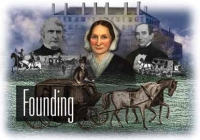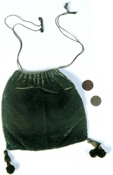
"Traveling the road from Boston to Connecticut often, Miss Lyon could scarce ride any ten miles of the route without being recognized by some fellow-traveller."
The year, 1834, was a turning point for Mary Lyon. She decided to leave Ipswich Female Seminary, where she was assistant principal, and focus all of her time and efforts on founding an institution of higher education for women. For the next three years, she crusaded tirelessly for funds and support. It was not the best time to ask people for donations--the United States was in a severe economic depression. But Mary Lyon persisted. She wrote circulars and ads announcing the plan for the school, raised money, persuaded prominent men to back her enterprise, developed a curriculum, visited schools and talked to educators as far away as Detroit, chose the school's location, supervised the design and construction of a building, brought equipment, hired teachers, and selected students. She endured ridicule from those who felt her ambitious undertaking would be "wasted" on women. Her constant travels often left her in a state of exhaustion. Yet, Mary Lyon never doubted her belief that women deserved to have the same opportunities for higher education as their brothers.

Green velvet bag. Mary Lyon traveled thousands of miles to raise funds, which she collected in this bag.
Mary Lyon's innovative goals for Mount Holyoke set the Seminary apart from other female seminaries of the period. They were:
- A curriculum equivalent to those at men's colleges.
- A minimum entrance age of 17.
- Low tuition to make education affordable to students from modest backgrounds. Mount Holyoke's was $60 a year.
- Rigorous entrance examinations to make sure students were adequately prepared.
- Permanence. A lack of funds forced many nineteenth-century female seminaries to close after a few years. A good number were proprietary, or owned by an individual, eager to make a profit. Some schools were so dependent upon the founder's popularity, that the institution collapsed after his or her death.
- Domestic work by students to keep operating expenses, and therefore, tuition, low.
- Independence. Mary Lyon sought no affiliations with a religious denomination or wealthy sponsor. Instead, she formed a board of trustees, a group of dedicated male supporters who donated their time to help Mount Holyoke thrive and succeed.
- A wide base of financial support. It was important to Mary Lyon that people from backgrounds like her own would feel that Mount Holyoke was a school for their daughters. She collected donations ranging from six cents to $1,000, as well as quilts and bedding from women's sewing circles and necessary items like stoves and furniture from trustees.

Mary Lyon's glasses and writing tablet. To raise funds for her school, Mary wrote hundreds of letters to prospective donors.
How was Mount Holyoke named?
What would Mary Lyon call the new seminary? A friend suggested "Pangynaskean," a Greek word meaning "all powers of women." Lyon decided "Mount Holyoke"--the name of a mountain near South Hadley, the town chosen for the Seminary's location--was a better choice.
Why did Mary Lyon call Mount Holyoke a "Seminary?"
In the nineteenth century, the words "seminary" and "college" were used to describe schools at a variety of levels. A college might give instruction either to university students, or to those of high school age and even younger. A seminary could be a preparatory school or offer a college education or graduate and professional training. Some historians believe Mary Lyon felt she would attract greater financial support using the name seminary rather than college for Mount Holyoke. The idea of a college for women was horrifying to many people in the 1830s.


Explore the MHC Social Universe >